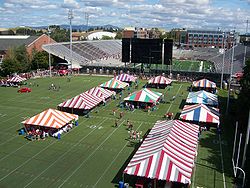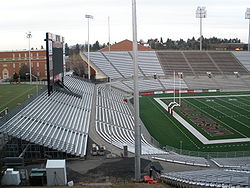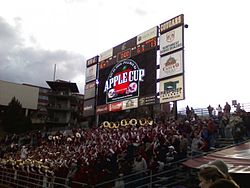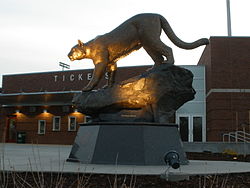- Martin Stadium
-
Martin Stadium
Martin Stadium in 2008, from SW cornerFormer names Rogers Field (1892–1970) Location Washington State University
720 NE Stadium Way
Pullman, Washington 99164
 United States
United StatesBroke ground 1971 Opened September 30, 1972 Renovated 1979, 2006- Owner Washington State University Operator Washington State University Surface FieldTurf - (2000– )
Omni-turf - (1990–99)
SuperTurf - (1979–89)
AstroTurf - (1972–78)Construction cost $1 million (undergoing a
$70 million renovation)Architect renovations by
Graham ConstructionCapacity 35,117 - (2006- )
37,600 - (1979-2005)
26,500 - (1972-78)Tenants Washington State Cougars (1972– )
(Pacific-12 Conference, NCAA)
Idaho Vandals - (1999–2001) NCAAMartin Stadium is an outdoor athletic stadium in Pullman, Washington, United States, on the campus of Washington State University. It is the home field of the Washington State Cougars of the Pacific-12 Conference, and is the smallest football stadium in the conference. The FieldTurf playing field runs an unorthodox east-west, at an elevation of 2,520 feet (770 m) above sea level.[1]
Contents
History
The stadium is named after Clarence D. Martin, the governor of the state of Washington from 1933–41, and a former mayor of Cheney, near Spokane and ironically, a graduate of the University of Washington. Martin Stadium opened on September 30, 1972, with a disappointing 19-point loss to Utah, then a member of the WAC,[2] with 20,600 in attendance. [3] Two and a half years had passed since its predecessor, the wooden Rogers Field, was significantly damaged by fire, a suspected case of arson.[4] The WSU Cougars played all of their home games at Joe Albi Stadium in Spokane in 1970 and 1971.
As of 2006, the stadium has a seating capacity of 35,117. Since the renovation of Reser Stadium at Oregon State, Martin Stadium has fallen to last in seating capacity among Pac-12 football stadiums. The current attendance record was set during the championship year of 1997, when WSU beat Stanford in front of 40,306 fans on November 15. (The '97 Cougar team won the Apple Cup in Seattle the following week to win the Pac-10, and played in the Rose Bowl for the first time in 67 years.) Despite the relatively small size of Martin Stadium, it has one of the highest ratios of seating capacity to population base; almost 1.6 seats per every citizen in the city of Pullman, and a seat for everyone in Whitman County.
1979 Expansion
Martin Stadium was the first college football stadium to expand by removing its 400 meter running track and lowering the playing field, in this case by 16 feet (5 m). This modification in 1979 added over 12,000 new seats, most of which were closer to the field (and the opponent's bench). The first game following the renovation was played in October 1979, a victory over the UCLA Bruins. Following a 10-3 season and an undefeated home campaign in 2003, Martin Stadium was ranked by Sports Illustrated as one of the toughest stadiums for visiting teams in college football.[citation needed]
Playing surface
The current playing surface is FieldTurf, first installed in 2000 and replaced in 2006,[5] it was preceded by the sand-filled Omni-turf, installed in 1990. The original playing surface at Martin Stadium in 1972 was AstroTurf, replaced by SuperTurf in 1979.[6] The playing surface at Rogers Field was natural grass.
Apple Cup
Modern-day Rogers Field[7] in 2008, directly west of Martin Stadium
Washington State hosts the Apple Cup in even-numbered years. Except for 1954, the Apple Cup was played at Joe Albi Stadium in Spokane from 1950–80, rather than in Pullman. The Cougars went 3-12 in these fifteen Spokane Apple Cups (winning in 1958, 1968, and 1972), while winning the previous games played at Rogers Field in Pullman (1948, 1954).
Since 1982, a Cougar victory, the rivalry game with UW has been played at Martin Stadium, with the Cougars winning six of the fourteen Pullman games. Through the 2009 season, WSU has won 4 out of the last 6 Apple Cup games, but trails in the overall series by a significant margin.[8]
Sharing with a rival
For two and a half seasons, 1999-2001, the Idaho Vandals of nearby Moscow borrowed Martin Stadium to use as its home field, as Idaho transitioned from Division I-AA back up to I-A. At the time, the Vandals' Kibbie Dome was too small to support the NCAA's attendance requirements for Division I-A. The attendance criteria was changed and Idaho is now a member of the WAC in Division I FBS, and uses its own facility.
Washington State and Idaho renewed their dormant football rivalry in 1998, and matched up annually in the Battle of the Palouse for a decade. The game was played at Martin Stadium in September, although the 2003 game was curiously played far from the Palouse, 300 miles (480 km) west at Seahawks Stadium in Seattle.[9] After a ten year renewal, new Vandal head coach Robb Akey, a former WSU defensive coordinator, stated that he preferred the game not be played every year.[10] The game was last played in 2007 and no games with Idaho are currently scheduled.
Fire at Rogers Field
At 10:30 p.m. on Saturday, April 4, 1970 (the first day of spring break), residents heard what they described as a gunshot at the football stadium. By 2:00 a.m., the south grandstand and press box of the 1930s wooden venue had burned to the ground, witnessed by a thousand residents and firefighters.[4] The exact cause, or offender, was never found, though there were several suspects.
The Cougars played their entire home schedule for the 1970 and 1971 football seasons at Joe Albi Stadium in Spokane. The fire also displaced the Idaho Vandals, whose wooden Neale Stadium was condemned before the 1969 season (and set afire by arson that November). The Vandals had used WSU's Rogers Field for its three Palouse home games in 1969 and were planning to use it again in for four home games in 1970. Without another suitable stadium in the Moscow-Pullman vicinity, Idaho played its 1970 home schedule at the reduced capacity Rogers Field, returning to its Moscow campus in 1971. The 1970 WSU-Idaho game in Spokane on September 19 was dubbed "The Displaced Bowl," and was easily won by the Cougars, 44-16, their only victory of the season.[11][12]
The name "Rogers Field" continues on campus, transferred to areas used for intramural sports and football practices west of the stadium.[7]
Tradition
The public address announcer at Martin Stadium is WSU professor Glenn Johnson, who is also the mayor of Pullman. Johnson is known for his first-down call of "...and that's ANOTHER...", to which the crowd responds by chanting "...COUGAR FIRST DOWN!" in unison along with Johnson.
Another Tradition at WSU is attending every ESPN College Gameday with WSU flags raised in the background during the show. The tradtion has lasted since 2004.
References
- ^ Topographic map and aerial photo from USGS via Microsoft Research Maps
- ^ cfbdatawarehouse.com - WSU results - 1970-74
- ^ Spokesman-Review - Utah beats Cougars 44-25 - 1972-10-01 - p.1 sports
- ^ a b Spokesman-Review - Fast blaze ruins Pullman stadium - 1970-04-06 - p.1
- ^ wsutoday.wsu.edu - Returfing Martin Stadium - 2006-06-02
- ^ wsucougars.cstv.com - Martin Stadium
- ^ a b "Remembering Rogers Field". Washingtonstate.scout.com. http://washingtonstate.scout.com/2/33621.html. Retrieved 2011-10-23.
- ^ cfbdatawarehouse.com - Apple Cup results
- ^ cfbdatawarehouse.com - WSU vs. Idaho
- ^ Smith, Craig (2006-12-21). "''Seattle Times''". Seattletimes.nwsource.com. http://seattletimes.nwsource.com/html/cougars/2003488062_coug21.html. Retrieved 2011-10-23.
- ^ cfbdatawarehouse - WSU results - 1970-74
- ^ "The Smilin' Irishman". Washingtonstate.scout.com. 2004-03-17. http://washingtonstate.scout.com/2/243292.html. Retrieved 2011-10-23.
External links
- MartinStadium.org - official site
- wsucougars.cstv.com - Martin Stadium
- World Stadiums.com - photos - Martin Stadium
- Aerial photo (& topographic map) - WSU campus from USGS via Microsoft Research Maps
Coordinates: 46°43′54.5″N 117°09′37.6″W / 46.731806°N 117.160444°W
Washington State Cougars football Established 1893 • Based in Pullman, Washington University Washington State University • Location: Pullman, Washington • President: Elson S. Floyd • Athletic Director: Bill MoosStadiums Rogers Field • Joe Albi Stadium • Martin StadiumHead coaches Goodyear • Waite • Brodie • Gailey • Shively • Allen • Namack • Ashmore • Sweeley • Bender • Rheinschild • Kienholz • Osthoff • Dietz • Alvord • Welch • Exendine • Hollingbery • Sarboe • Evashevski • Kircher • Sutherland • Clark • Sweeney • Sherrill • Powers • Walden • Erickson • Price • Doba • WulffConference affiliations Pacific Coast Conference (PCC) • Athletic Association of Western Universities (AAWU) • Pacific-8 Conference (Pac-8) • Pacific-10 Conference (Pac-10) • Pacific-12 Conference (Pac-12)Culture Rivalries Bowl games 1916 Rose Bowl • 1931 Rose Bowl • 1981 Holiday Bowl • 1988 Aloha Bowl • 1992 Copper Bowl • 1994 Alamo Bowl • 1998 Rose Bowl • 2001 Sun Bowl • 2003 Rose Bowl • 2003 Holiday BowlConference
championships (4)1917 • 1930 • 1997 • 2002Seasons (118) 1890s 1893 • 1894 • 1895 • 1896 • 1897 • 1898 • 18991900s 1900 • 1901 • 1902 • 1903 • 1904 • 1905 • 1906 • 1907 • 1908 • 19091910s 1910 • 1911 • 1912 • 1913 • 1914 • 1915 • 1916 • 1917 • 1918 • 19191920s 1920 • 1921 • 1922 • 1923 • 1924 • 1925 • 1926 • 1927 • 1928 • 19291930s 1930 • 1931 • 1932 • 1933 • 1934 • 1935 • 1936 • 1937 • 1938 • 19391940s 1940 • 1941 • 1942 • 1943 • 1944 • 1945 • 1946 • 1947 • 1948 • 19491950s 1950 • 1951 • 1952 • 1953 • 1954 • 1955 • 1956 • 1957 • 1958 • 19591960s 1960 • 1961 • 1962 • 1963 • 1964 • 1965 • 1966 • 1967 • 1968 • 19691970s 1970 • 1971 • 1972 • 1973 • 1974 • 1975 • 1976 • 1977 • 1978 • 19791980s 1980 • 1981 • 1982 • 1983 • 1984 • 1985 • 1986 • 1987 • 1988 • 19891990s 1990 • 1991 • 1992 • 1993 • 1994 • 1995 • 1996 • 1997 • 1998 • 19992000s 2010s 2010Football stadiums of the Pacific-12 Conference North Division California Memorial Stadium/AT&T Park (California) • Autzen Stadium (Oregon) • Reser Stadium (Oregon State) • Stanford Stadium (Stanford) Husky Stadium (Washington) • Martin Stadium (Washington State) •
South Division Arizona Stadium (Arizona) • Sun Devil Stadium (Arizona State) Folsom Field (Colorado) • Los Angeles Memorial Coliseum (Southern California) • Rose Bowl (UCLA) • Rice–Eccles Stadium (Utah) •
College football venues in Washington Division I
FBSPac-12 Husky Stadium (Washington) • Martin Stadium (Washington State)
Division I
FCSBig Sky Roos Field (Eastern Washington)
Division II GNAC Tomlinson Stadium (Central Washington)
Division III Northwest Baker Stadium (Puget Sound) • Sparks Stadium (Pacific Lutheran) • Whitworth Pine Bowl (Whitworth)
Joe Albi Stadium • CenturyLink Field Categories:- College football venues
- American football venues in Washington (state)
- Washington State Cougars football venues
- Idaho Vandals football venues
- Buildings and structures in Whitman County, Washington
Wikimedia Foundation. 2010.





